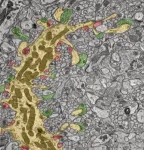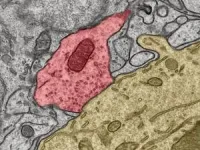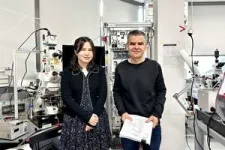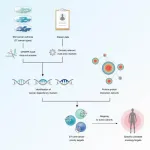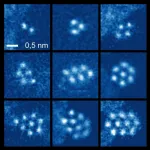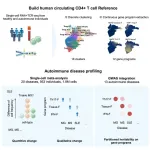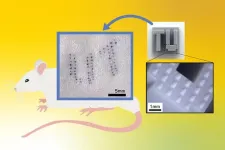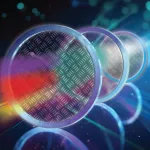(Press-News.org) Whether picking up a small object like a pen or coordinating different body parts, the cerebellum in the brain performs essential functions for controlling our movement. Researchers at the Institute of Science and Technology Austria (ISTA) investigated how a crucial set of synapses between neurons within it functions and develops. Their findings have now been published in the journal Neuron.
Even if you do not think about it, every day you are using the intricate circuits of neurons in your brain to perform astonishingly delicate movements with your body. One essential unit in this is the cerebellum playing a key role in fine motor control, coordination, and timing.
“Every time I go climbing, I make use of complex structures in the connections between neurons—the synapses—in my cerebellum. In this project, we wanted to understand how they actually work,” Peter Jonas, Magdalena Walz Professor for Life Sciences at the Institute of Science and Technology Austria (ISTA), relates his research to his everyday experiences. In a new study, now published in the journal Neuron and led by PhD student Jingjing Chen in Jonas’ research group and Walter Kaufmann from ISTA’s Electron Microscopy Facility with crucial support from ISTA’s Professor Ryuichi Shigemoto, the scientists unraveled some of the key mechanisms in the synapses of the cerebellum.
Controlling Synapses
“The cerebellum receives a lot of inputs from the other parts of the brain and from sensory systems but its output signals controlling movement all go through a critical kind of neuron called Purkinje cell,” Chen explains. “And in turn all these Purkinje cells each get a lot of signals from other neurons in the cerebellum through their input synapses. We looked at a specific kind of synapse that inhibits the activity of the Purkinje cells and plays a crucial role in controlling their output signals.”
The Purkinje cells in the cerebellum form a bottleneck for its motor control signals, but many aspects of how this is achieved on a molecular and cellular level have remained unclear. In their study, the researchers have now uncovered the details of the cells’ inhibitory synapses.
The researchers used subcellular patch clamp recording, guided by an advanced light microscopy technique called online confocal imaging, to look at the function of these synapses in great detail. In parallel, they used electron microscopy to study the structure of the synapses at highest possible resolution. Some of the features they were looking at are just a few nanometers—millionths of a millimeter—in size. Chen and her colleagues measured a variety of parameters of the synapses, like where and how often neurotransmitters are being released, as well as the size of the tiny bubbles that contain the neurotransmitters in order to build a computer model of the whole process. They did this with neurons from brains of mice at different ages to understand their development over time.
Jonas, who developed the computer model, adds, “Building a model lets you properly understand a system and also sparks new ideas for future experiments. However, you have to be careful and keep it grounded in reality with experimental data.”
With their computer model simulating what is going on at different stages of development from early to adult age, the scientists could see how the inhibitory synapses of the Purkinje cells in the cerebellum delicately influence the cell’s signal output allowing for fine control of motor skills.
Emerging Structure
“We found that, at an early age, all the mechanisms in the synapse are quite randomly organized and are not that exact in their functions,” Kaufmann, who joined ISTA as one of the first staff scientists about ten years ago, explains the results. “As the circuit matures, the synapse becomes more structured, approaching a point-to-point configuration, and thereby reaches a higher level of functional precision”. Chen, who wants to continue her work on the cerebellum after her PhD, adds, “The tricky thing was that we cannot just ask the cells directly how they work. Instead, we have to take snapshots—meaning measurements—at different stages of development and deduce the processes and overall structure behind them.”
Understanding this kind of synapse is not just a worthwhile endeavor in fundamental science, but, in the future, may even help researchers to address neurological diseases whose cause is indicated to lie in a malfunctioning of synapses in the brain.
Jonas adds, “This project created a bridge between the biophysical properties of synapses and what we can actually observe under the microscope. It is a great step forward in understanding the details of how the cerebellum helps us control and coordinate our movement. Initially, the required experiments seemed impossible, but with the support of Ryuichi Shigemoto, as well as our dedicated colleagues from the Jonas group and the scientific service units, we managed to bring our understanding of these crucial synapses to the point.”
---
Information on Animal Studies
To holistically understand how genes act during development of an organ, such as the brain, it is essential to study their function in mice in vivo. No other methods, such as in vitro or in silico models, can serve as alternatives. The animals are raised, kept, and treated according to the strict regulations of Austrian law. All animal procedures are approved by the Federal Ministry of Education, Science and Research.
END
Synapses brought to the point
Scientists unravel structure and function of important inhibitory synapses in the cerebellum
2024-01-11
ELSE PRESS RELEASES FROM THIS DATE:
Catalytic combo converts CO2 to solid carbon nanofibers
2024-01-11
UPTON, NY—Scientists at the U.S. Department of Energy’s (DOE) Brookhaven National Laboratory and Columbia University have developed a way to convert carbon dioxide (CO2), a potent greenhouse gas, into carbon nanofibers, materials with a wide range of unique properties and many potential long-term uses. Their strategy uses tandem electrochemical and thermochemical reactions run at relatively low temperatures and ambient pressure. As the scientists describe in the journal Nature Catalysis, this approach could successfully lock carbon away in a useful solid form to offset or even achieve negative carbon emissions.
“You can put the carbon nanofibers ...
Substance use disorders among adult cancer survivors
2024-01-11
About The Study: The findings of this study of 6,101 adult cancer survivors suggest that substance use disorder (SUD) prevalence is higher among survivors of certain types of cancer; this information could be used to identify cancer survivors who may benefit from integrated cancer and SUD care. Future efforts to understand and address the needs of adult cancer survivors with comorbid SUD should prioritize cancer populations in which SUD prevalence is high.
Authors: Devon K. Check, Ph.D., of the Duke University School of Medicine in Durham, North Carolina, is the corresponding author.
To access the ...
Head and neck cancer incidence before and during the pandemic
2024-01-11
About The Study: In this study of patients diagnosed with head and neck cancer from 2017 to 2020 in the U.S., the incidence of localized head and neck cancer declined during the first year of the pandemic. A subsequent increase in advanced-stage diagnoses may be observed in later years.
Authors: Nosayaba (Nosa) Osazuwa-Peters, B.D.S., Ph.D., M.P.H., C.H.E.S., of the Duke University School of Medicine in Durham, North Carolina, is the corresponding author.
To access the embargoed study: Visit ...
Wellcome Sanger Institute: Cancer drug discovery accelerated as hundreds of overlooked targets prioritised
2024-01-11
A new, systematic analysis of cancer cells identifies 370 candidate priority drug targets across 27 cancer types, including breast, lung and ovarian cancers.
By looking at multiple layers of functional and genomic information, researchers were able to create an unbiased, panoramic view of what enables cancer cells to grow and survive. They identify new opportunities for cancer therapies in a significant leap towards a new generation of smarter, more effective cancer treatments.
In the most comprehensive study of its kind, researchers ...
ChatGPT has read almost the whole internet. That hasn't solved its diversity issues
2024-01-11
AI language models are booming. The current frontrunner is ChatGPT, which can do everything from taking a bar exam, to creating an HR policy, to writing a movie script.
But it and other models still can’t reason like a human. In this Q&A, Dr. Vered Shwartz (she/her), assistant professor in the UBC department of computer science, and masters student Mehar Bhatia (she/her) explain why reasoning could be the next step in AI—and why it’s important to train these models using diverse ...
First direct imaging of small noble gas clusters at room temperature
2024-01-11
For the first time, scientists have succeeded in the stabilisation and direct imaging of small clusters of noble gas atoms at room temperature. This achievement opens up exciting possibilities for fundamental research in condensed matter physics and applications in quantum information technology. The key to this breakthrough, achieved by scientists at the University of Vienna in collaboration with colleagues at the University of Helsinki, was the confinement of noble gas atoms between two layers of graphene. This method overcomes the difficulty that noble gases do not form stable structures under experimental conditions ...
CD4+ T cell patterns linked to autoimmune disorders
2024-01-11
Osaka, Japan – Much like ripples on the water can betray powerful currents below the surface, small changes in our bodies can sometimes be an indicator of a serious condition. Now, researchers from Japan say that cells in the blood may provide telltale signs of important immune dysfunction.
In a study recently published in Cell Genomics, researchers from Osaka University have revealed that subtle changes in specific immune cell populations may signal the presence of an autoimmune disease.
In autoimmune conditions, which affect up to 5% of the population, the body’s immune cells attack the body ...
A tiny tattoo for a tabby
2024-01-11
Tokyo, Japan – If you’ve ever taken a car trip through a rural area, you might already know that livestock, including cows and sheep, can be individually tracked using decidedly old-fashioned methods, such as ear tags or even branding marks. By contrast, many tech-savvy pet owners have opted to have their dog or cat “chipped” by having a radio frequency identification (RFID) permanently implanted under the skin. However, all these identification solutions leave something to be desired, as ear tags can become damaged or lost, while RFID chips require an invasive procedure to insert and specialized equipment to read.
In a study recently published in Scientific ...
JMIR AI has passed the Scientific Quality Review by NLM for PMC
2024-01-11
JMIR Publications is pleased to announce that JMIR AI has passed the Scientific Quality Review by the US National Library of Medicine (NLM) for PubMed Central (PMC). This decision reflects the scientific and editorial quality of the journal. All articles published from 2022 onward will be found on PMC and PubMed after their technical evaluation.
Launched in 2022, JMIR AI is a new journal that focuses on the applications of artificial intelligence in health settings. This includes contemporary developments as well as historical ...
Researchers use spinning metasurfaces to craft compact thermal imaging system
2024-01-11
WASHINGTON — Researchers have developed a new technology that uses meta-optical devices to perform thermal imaging. The approach provides richer information about imaged objects, which could broaden the use of thermal imaging in fields such as autonomous navigation, security, thermography, medical imaging and remote sensing.
“Our method overcomes the challenges of traditional spectral thermal imagers, which are often bulky and delicate due to their reliance on large filter wheels or interferometers,” said research team leader Zubin Jacob from ...
LAST 30 PRESS RELEASES:
Heart-brain connection: international study reveals the role of the vagus nerve in keeping the heart young
Researchers identify Rb1 as a predictive biomarker for a new therapeutic strategy in some breast cancers
Survey reveals ethical gaps slowing AI adoption in pediatric surgery
Stimulant ADHD medications work differently than thought
AI overestimates how smart people are, according to HSE economists
HSE researchers create genome-wide map of quadruplexes
Scientists boost cell "powerhouses" to burn more calories
Automatic label checking: The missing step in making reliable medical AI
Low daily alcohol intake linked to 50% heightened mouth cancer risk in India
American Meteorological Society announces Rick Spinrad as 2026 President-Elect
Biomass-based carbon capture spotlighted in newly released global climate webinar recording
Illuminating invisible nano pollutants: advanced bioimaging tracks the full journey of emerging nanoscale contaminants in living systems
How does age affect recovery from spinal cord injury?
Novel AI tool offers prognosis for patients with head and neck cancer
Fathers’ microplastic exposure tied to their children’s metabolic problems
Research validates laboratory model for studying high-grade serous ovarian cancer
SIR 2026 delivers transformative breakthroughs in minimally invasive medicine to improve patient care
Stem Cell Reports most downloaded papers of 2025 highlight the breadth and impact of stem cell research
Oxford-led study estimates NHS spends around 3% of its primary and secondary care budget on the health impacts of heat and cold in England
A researcher’s long quest leads to a smart composite breakthrough
Urban wild bees act as “microbial sensors” of city health.
New study finds where you live affects recovery after a hip fracture
Forecasting the impact of fully automated vehicle adoption on US road traffic injuries
Alcohol-related hospitalizations from 2016 to 2022
Semaglutide and hospitalizations in patients with obesity and established cardiovascular disease
Researchers ‘listen in’ to embryo-mother interactions during implantation using a culture system replicating the womb lining
How changing your diet could help save the world
How to make AI truly scalable and reliable for real-time traffic assignment?
Beyond fragmented markets: A new framework for efficient and stable ride-pooling
Can shape priors make road perception more reliable for autonomous driving?
[Press-News.org] Synapses brought to the pointScientists unravel structure and function of important inhibitory synapses in the cerebellum
